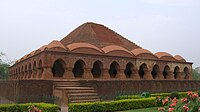Hinduism in West Bengal
Malda. | |
| Languages | |
|---|---|
| Majority: Bengali Minority: Nepali and Hindi | |
| Religion | |
| Hinduism and others |
This article needs additional citations for verification. (March 2023) |
| Part of a series on |
| Hinduism |
|---|
 |
Hinduism is the largest
Hinduism had existed in the region of
Culture
The language of the Hindus in West Bengal is
Religion
Majority of Bengali Hindus follow
The main
Festivals

Temples
-
Kalighat Temple.
-
The temple atCaitanya Mahaprabhu's birthplace in Mayapur, Nadia established by Bhaktivinoda Thakurin the 1880s.
-
Hangseshwari and Vasudev temple at Hooghly district.
-
Sri Ramakrishna Temple, Belur Math.
-
Rashmancha Temple, Bishnupur
Temple architecture in West Bengal architecture has assumed a unique identity and evolved into the
The Bengali style of temple is not luxurious. Rather, most are modeled on simple thatched-roof earthen huts used as dwellings by commoners. This can be attributed to the popularity of
Demography
Hindus constituted 78.45% of West Bengal’s population way back in 1951. As per the 2011 census, 70.54% of the state’s population is Hindu. There is sharp decline of 7.91% hindu population in 6 decades.[8][9]
| # | District | Total population | Hindu population | % |
|---|---|---|---|---|
| 1 | North 24 Parganas | 10,009,781 | 7,352,769 | 73.46% |
| 2 | Barddhaman |
7,717,563 | 6,008,472 | 77.85% |
| 3 | South 24 Parganas |
8,161,961 | 5,155,545 | 63.17% |
| 4 | Paschim Medinipur | 5,913,457 | 5,056,953 | 85.52% |
| 5 | Hooghly | 5,519,145 | 4,574,569 | 82.89% |
| 6 | Purba Medinipur | 5,095,875 | 4,343,972 | 85.24% |
| 7 | Nadia | 5,167,600 | 3,728,482 | 72.15% |
| 8 | Howrah | 4,850,029 | 3,535,844 | 72.90% |
| 9 | Kolkata | 4,496,694 | 3,440,290 | 76.51% |
| 10 | Jalpaiguri | 3,872,846 | 3,156,781 | 81.51% |
| 11 | Bankura | 3,596,674 | 3,033,581 | 84.34% |
| 12 | Puruliya |
2,930,115 | 2,373,120 | 80.99% |
| 13 | Murshidabad | 7,103,807 | 3,359,061 | 33.21% |
| 14 | Birbhum | 3,502,404 | 2,181,515 | 62.29% |
| 15 | Cooch Behar | 2,819,086 | 2,087,766 | 74.06% |
| 16 | Maldah |
3,988,845 | 1,914,352 | 47.99% |
| 17 | Uttar Dinajpur | 3,007,134 | 1,482,943 | 49.31% |
| 18 | Darjeeling | 1,846,823 | 1,366,681 | 74.00% |
| 19 | Dakshin Dinajpur | 1,676,276 | 1,232,850 | 73.55% |
| West Bengal (Total) | 91,276,115 | 64,385,546 | 70.54% |
Economy and business
Economic participation, work roles and distribution across professions for Bengali Hindus is similar to the wider population in the rural areas, where agriculture and related activities remain the primary occupation. In the urban areas, the largest segment of the Hindu population is engaged mostly as services professionals across sectors.
Historically, since the advent of
This continued to the 20th century when luminaries like Prafulla Chandra Ray established Bengal Chemicals and Pharmaceuticals, Rajendra Nath Mookerjee formed engineering firm Martin Burn and Surendra Mohan Bose created the Duckback brand during the Swadeshi movement, among many others.[11]
In India, after
Average literacy levels of Bengali Hindus remain higher than other communities in West Bengal. However, the opposite is true for the minority Hindu population in Bangladesh.
Noted West Bengali Hindu industrialists include:
- Gouri Sen
- Gourmohan Dutta of GD Pharmaceuticals-manufacturers
- Hari Ghosh
- Banamali Sarkar
- Gobindram Mitter
- Prasanna Coomar Tagore
- Ramanath Tagore
- Rajen Mookerjee
- Rajat Kumar Gupta
- Alamohan Das
- Dwarkanath Tagore
- Purnendu Chatterjee of The Chatterjee Group & Haldia Petrochemicals
- Prashant Mukherjee
- Sadhan Dutt
- Subrata Roy of Sahara India Pariwar
- Sanjit Biswas
- Amar Gopal Bose of Bose Corporation
- Aveek Sarkar
See also
- Hinduism in India
- Religion in West Bengal
- Hinduism in East Bengal
- East Bengali refugees
- Bengali Hindus.
References
- ^ Census, India (24 August 2022). "West Bengal Population". IndiaCensus.net.
- ^ ISBN 0-02-865735-7. p. 826.
- ^ Zbonkak, Trevor (14 December 2021). "How many Bengalis are there in West Bengal?". The Flat - Travel Q&A and Tips 2022. Retrieved 20 July 2022.
- ^ a b Datta, Romita (13 November 2020). "The great Hindu vote trick". India Today. Retrieved 11 May 2021.
- ^ "Population of West Bengal-West Bengal Population 2021". India Guide- Festivals, Culture, City Guide, Weddings, Population, Indianonlinepages.com. Retrieved 10 July 2021.
- ^ "Opinion divided on most non-Bengali voters favouring BJP in West Bengal". Retrieved 12 July 2021.
- ISBN 81-86908-97-8.
- ^ "Decline of Hindu population in West Bengal worries RSS". The Times of India. 26 March 2017.
- ^ "Bengal election: How BJP and TMC are using old census data to fuel identity-based politics". 29 March 2021.
- ^ Population by religious community: West Bengal. 2011 Census of India.
- ^ "Duckback-Surendra Mohan Bose who dared to challenge British monopoly of 100 years". getbengal.com. Retrieved 25 August 2020.
Further links
- Chatterjee, Chandra (2020f). Syama Prasad Mookerjee, the Hindu Dissent and the Partition of Bengal, 1932-1947. Manohar Publishers. OCLC 1158770381.
External links
- "Religion share in West Bengal", 2011 Census of India, Government of India






